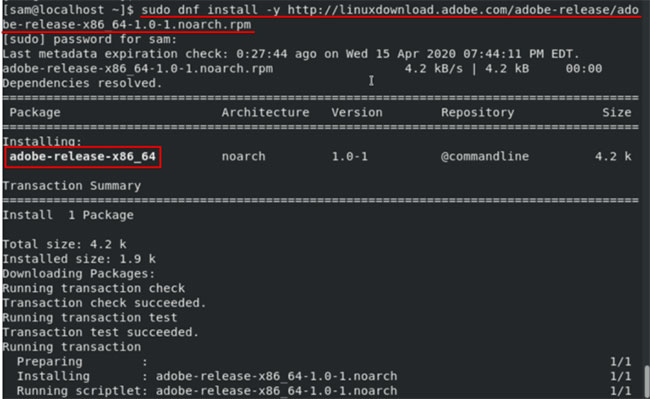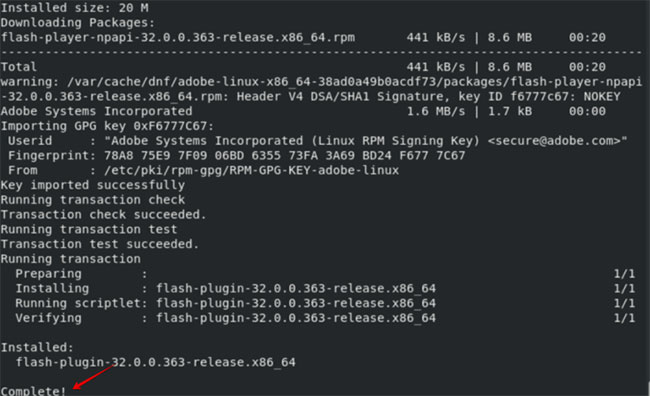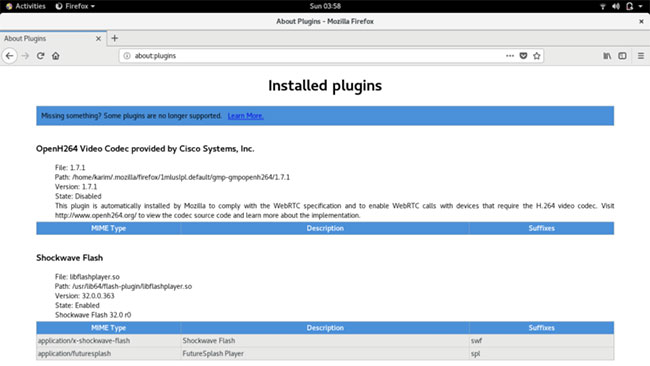How to install Adobe Flash Player on CentOS 8
Adobe Flash Player is still an essential browser plug-in used to play audio, stream videos and other multimedia content on Adobe Flash websites or platforms. It supports many different web browsers such as Internet Explorer, Firefox and Opera. Adobe Flash Player can also be installed on many types of operating systems, including Windows, MacOS, Linux / UNIX and Android.
In this article, you will learn how to install Adobe Flash Player on CentOS 8 using Terminal.
Install Adobe Flash Player on CentOS 8
To install Adobe Flash Player on the system, you need to perform the following steps with Terminal.
1. Open a Terminal window with the shortcut shortcut Ctrl+ Alt+ T.
2. You need to log in as the root user on the system to install.
Update system package
You should update your system before installing any new software on it. Enter the following command to update the operating system:
$sudo dnf makecacheYou also need to upgrade the packages already installed on the system. Use the following command to upgrade the system packages:
$sudo dnf -y upgradeAdd the adobe yum repository to the system
In this step, you will add the adobe yum repository to the CentOS 8. To add the adobe yum repository, use the following command:
$sudo dnf install -y http://linuxdownload.adobe.com/adobe-release/adobe-release-x86_64-1.0-1.noarch.rpm Add the adobe yum repository to the system
Add the adobe yum repository to the system After a few moments, you will see the status of 'Complete' displayed on the Terminal window, for the adobe yum repository added to the system.
Install Adobe Flash Player
Now, it's time to install Adobe Flash Player on the system. To install Adobe Flash Player on a CentOS 8 workstation, you need to execute the following command on Terminal:
$sudo dnf install -y libcurl flash-plugin alsa-plugins-pulseaudioThis process will take some time, after that, you will see that the Adobe Flash Player installation has been completed on the system.
 Install Adobe Flash Player
Install Adobe Flash Player Verify Adobe Flash Player installation
You will have to verify that Adobe Flash Player is already installed on the system. Enter Adobe in the search bar, see if it's available on CentOS 8's desktop. If it is installed, you will see the icon of Adobe Flash Player.
 You will see the icon of Adobe Flash Player
You will see the icon of Adobe Flash Player You can also verify that Adobe Flash Player is used in your browser, by opening the Firefox browser on the system and entering the following in the address bar:
about:plugins You can also verify that Adobe Flash Player is used on your browser
You can also verify that Adobe Flash Player is used on your browser Now, the installation has been successfully established on the system. You can enjoy the benefits of Adobe Flash Player on your Linux CentOS 8 system.
You should read it
- How to Update Adobe Flash Player
- New improvements in Adobe Flash Player 10.1
- Instructions for troubleshooting Flash Player crash (crash) in the browser
- Disable Adobe Flash on Edge browser
- Adobe said goodbye to Flash Media Player by 2020
- Journey from the face of the Internet to the stepchild is forgotten
- How to Enable Flash Player on Mac
- Instead of killing Flash, we should save it for posterity
May be interested
- Instead of killing Flash, we should save it for posterity
 adobe has decided to launch flash player in 2020, but not only has important implications in internet history, flash also contains a lot of content that we probably won't want to leave.
adobe has decided to launch flash player in 2020, but not only has important implications in internet history, flash also contains a lot of content that we probably won't want to leave. - How to clear the cache and set up Adobe Flash Player?
 in the series of articles about adobe flash player, we have some basic skills to fix common problems with flash player in the browser. but how to delete the cache - cache and settings - settings of flash player? read the lower part of the article!
in the series of articles about adobe flash player, we have some basic skills to fix common problems with flash player in the browser. but how to delete the cache - cache and settings - settings of flash player? read the lower part of the article! - Instructions for installing Adobe Flash on Vivaldi browser
 currently many websites use html 5, to be able to access these websites requires you to install adobe flash. in case you browse the web on vivaldi browser, the website will ask you to install install adobe flash player.
currently many websites use html 5, to be able to access these websites requires you to install adobe flash. in case you browse the web on vivaldi browser, the website will ask you to install install adobe flash player. - How to completely remove Adobe Flash on a Mac
 with support officially over, adobe 'sincerely' recommends that users remove flash from their computers. in the article below, tipsmake will guide you how to completely remove adobe flash on a mac.
with support officially over, adobe 'sincerely' recommends that users remove flash from their computers. in the article below, tipsmake will guide you how to completely remove adobe flash on a mac. - How to Unblock Flash Player
 this article shows you how to enable flash player on your computer's browser. flash player supports the display of flash content, such as videos and images, when you open a web page. you can enable flash player from the settings menu of google chrome, microsoft edge, internet explorer, and safari, but you'll need to download adobe flash player if you want to view flash content in firefox.
this article shows you how to enable flash player on your computer's browser. flash player supports the display of flash content, such as videos and images, when you open a web page. you can enable flash player from the settings menu of google chrome, microsoft edge, internet explorer, and safari, but you'll need to download adobe flash player if you want to view flash content in firefox. - Adobe released Flash Player 10
 on october 15, adobe systems released an upgraded version of flash player 10 to provide a more enjoyable video, audio and graphics experience.
on october 15, adobe systems released an upgraded version of flash player 10 to provide a more enjoyable video, audio and graphics experience. - How to update Flash Player on your computer
 how to update flash player on your computer. adobe flash player is a plugin that is responsible for running flash programs on the web such as web games, online videos ... in order for flash player to work properly, we must regularly update flash player to the latest version.
how to update flash player on your computer. adobe flash player is a plugin that is responsible for running flash programs on the web such as web games, online videos ... in order for flash player to work properly, we must regularly update flash player to the latest version. - Instructions to disable Flash Player on all browsers
 sometimes the errors involved and originating from adobe flash player are the main reason you feel uncomfortable, or even consume your computer's system resources. therefore, it is good to use flash player flexibly or disable flash player.
sometimes the errors involved and originating from adobe flash player are the main reason you feel uncomfortable, or even consume your computer's system resources. therefore, it is good to use flash player flexibly or disable flash player. - 5 simple steps to activate Flash in Chrome
 the following article will show you how to enable adobe flash player in chrome and better still keep flash disabled until you click on it.
the following article will show you how to enable adobe flash player in chrome and better still keep flash disabled until you click on it. - Download Adobe ShockWave Player 12.3.5.205
 formerly macromedia shockwave player, adobe shockwave player is a free plugin for viewing multimedia, interactive content and web pages created in swf format.
formerly macromedia shockwave player, adobe shockwave player is a free plugin for viewing multimedia, interactive content and web pages created in swf format.










 How to find devices connected to the network using Debian
How to find devices connected to the network using Debian How to play The Witcher 3 on Linux
How to play The Witcher 3 on Linux How to install VPN on Ubuntu
How to install VPN on Ubuntu How to create self-extracting archives with shar in Linux
How to create self-extracting archives with shar in Linux 5 best open source backup utilities for Linux
5 best open source backup utilities for Linux How to set the JAVA_HOME path in Debian 10
How to set the JAVA_HOME path in Debian 10